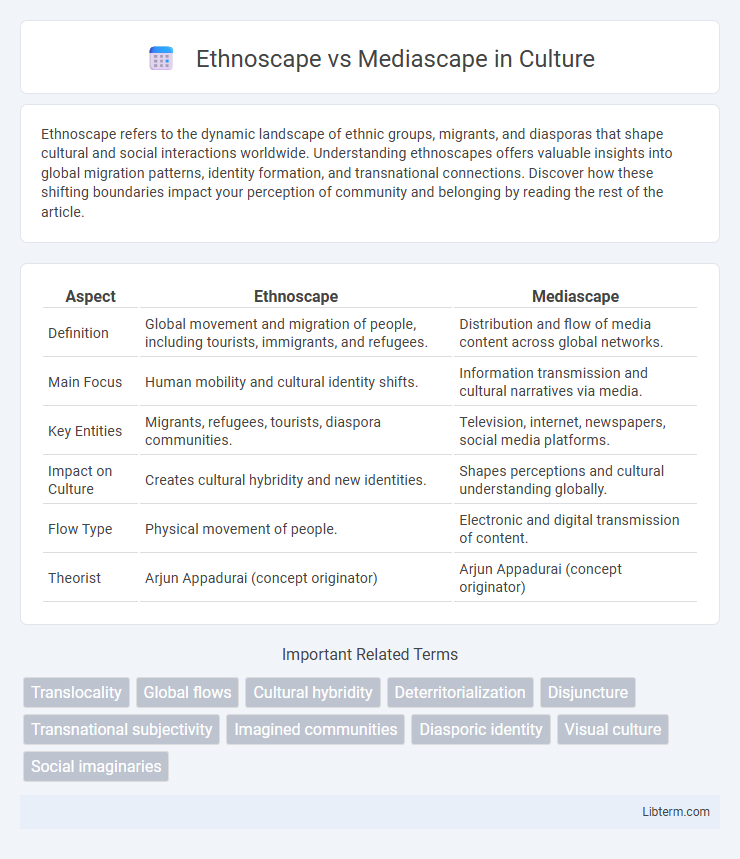Ethnoscape refers to the dynamic landscape of ethnic groups, migrants, and diasporas that shape cultural and social interactions worldwide. Understanding ethnoscapes offers valuable insights into global migration patterns, identity formation, and transnational connections. Discover how these shifting boundaries impact your perception of community and belonging by reading the rest of the article.
Table of Comparison
| Aspect | Ethnoscape | Mediascape |
|---|---|---|
| Definition | Global movement and migration of people, including tourists, immigrants, and refugees. | Distribution and flow of media content across global networks. |
| Main Focus | Human mobility and cultural identity shifts. | Information transmission and cultural narratives via media. |
| Key Entities | Migrants, refugees, tourists, diaspora communities. | Television, internet, newspapers, social media platforms. |
| Impact on Culture | Creates cultural hybridity and new identities. | Shapes perceptions and cultural understanding globally. |
| Flow Type | Physical movement of people. | Electronic and digital transmission of content. |
| Theorist | Arjun Appadurai (concept originator) | Arjun Appadurai (concept originator) |
Introduction to Ethnoscape and Mediascape
Ethnoscape refers to the dynamic flow of people across borders, including migrants, refugees, tourists, and ethnic communities, shaping global cultural landscapes. Mediascape encompasses the distribution of electronic capabilities to produce and disseminate information through media outlets like television, film, and the internet, influencing public perception and cultural narratives. These concepts, introduced by Arjun Appadurai, highlight how global movement of individuals and media technology interconnect to redefine identity and social spaces in the modern world.
Defining Ethnoscape: Mobility of People
Ethnoscape refers to the landscape of people who constitute the shifting world in which individuals live, highlighting the movement and migration of ethnic groups, tourists, refugees, and immigrants across geographical boundaries. This concept captures the fluidity of cultural identities shaped by global migration patterns, exile, and diasporas. In contrast, mediascape centers on the distribution of electronic and print media, influencing perceptions and narratives globally, but lacks the direct physical movement intrinsic to ethnoscapes.
Understanding Mediascape: Flow of Information
Mediascape refers to the global distribution and flow of information through various media channels, including television, films, newspapers, and digital platforms, shaping how societies perceive events and cultures. This flow of information influences public opinion, cultural norms, and political discourse by controlling narratives and framing realities across borders. Understanding mediascape highlights the power of media conglomerates and technologies in directing global communication and cultural exchange.
Historical Evolution of Ethnoscape and Mediascape
Ethnoscape refers to the fluctuating landscape of individuals and groups moving across borders, shaped by migration, globalization, and diasporic histories, while mediascape denotes the distribution of electronic and print media that influences cultural perceptions worldwide. Historically, ethnoscapes evolved from colonial-era migrations and trade routes, expanding through 20th-century labor movements and refugee flows, reflecting increasing global interconnectedness. Mediascapes emerged with the rise of mass media in the 20th century, intensifying after the digital revolution, enabling transnational communication and the widespread dissemination of cultural narratives.
Key Differences Between Ethnoscape and Mediascape
Ethnoscape refers to the flow and movement of people such as migrants, refugees, and tourists across the globe, shaping cultural identities and social landscapes. Mediascape involves the distribution and consumption of images, information, and narratives through mass media channels, influencing public perception and cultural meaning. Key differences lie in their focus: ethnoscape emphasizes human mobility and cultural diversity, while mediascape centers on the communication of information and the construction of shared social realities.
Interconnections: How Ethnoscapes Influence Mediascapes
Ethnoscapes shape mediascapes by providing diverse cultural narratives and identities that inform media content and representation, enhancing global communication flows. The dynamic movement of people across borders introduces new stories and perspectives into media landscapes, enriching visual and textual frameworks. This interaction fosters cross-cultural understanding and influences how global audiences consume and interpret media, highlighting the significance of ethnoscapes in the evolution of mediascapes.
Mediascapes Shaping Perceptions in Ethnoscapes
Mediascapes influence ethnoscapes by shaping how cultures and identities are perceived and represented across global landscapes. Through diverse media channels such as television, film, and social networks, mediated images and narratives construct collective understandings of ethnic communities and diasporas. These representations affect migration decisions, social integration, and cultural exchanges, highlighting mediascapes' critical role in transforming the dynamics of ethnoscapes.
Real-World Examples of Ethnoscape and Mediascape Interactions
Ethnoscape and mediascape interact dynamically in global cities where migrant communities use digital platforms to maintain cultural ties while adapting to new environments, as seen in New York's Chinatown using social media to share local events and transnational news. Refugees in Europe utilize ethnoscape networks combined with mediascape tools to navigate identity and access resources, exemplified by Syrian communities engaging with online media to influence both local integration and international awareness. These interactions highlight how physical movement of people blends with the flow of information, shaping collective identities and transnational social landscapes.
Implications in Globalization and Cultural Identity
Ethnoscape refers to the shifting landscape of people and migration patterns that influence cultural identity through the movement of individuals and communities across borders. Mediascape encompasses the global distribution of electronic and print media that shapes public perception, cultural narratives, and identity formation worldwide. The interplay between ethnoscape and mediascape highlights how globalization redefines cultural identities through transnational flows of people and mediated information, fostering hybrid identities while challenging traditional cultural boundaries.
Future Trends and Challenges in Ethnoscapes and Mediascapes
Ethnoscapes and mediascapes are evolving rapidly with increased globalization and digital connectivity, shaping cultural identities and migration patterns. Future trends in ethnoscapes highlight growing transnational communities and hybrid identities, while mediascapes face challenges in managing misinformation, digital surveillance, and cultural homogenization. Both realms demand innovative policies to balance cultural diversity, technological advancements, and ethical media practices in an interconnected world.
Ethnoscape Infographic

 libterm.com
libterm.com